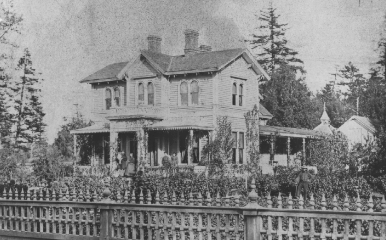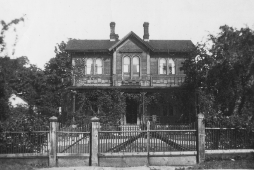| Date | Information | Source |
|---|---|---|
| July 5, 1863 | Carr arrived in Esquimalt | Carr Diary |
| Aug. 13, 1863 | Land purchased from Col. Moody
Three men began clearing land. |
Carr Journal |
| Aug. 29, 1863 | Advertised for tenders for building house. | Carr Journal |
| Oct. 31, 1863 | Payment to Wright & Sanders, Architects. | Carr Journal |
| March 4, 1864 | Final payment to Graham & Morris, Contractors | Carr Journal |
| April 1, 1864 | Moved into house. | Carr Diary |
| April 15, 1864 | Final payment to Wright & Sanders, Architects. | Carr Journal |
To date, none of the drawings produced by Wright & Sanders, Archtiects, for the Richard Carr residence have been discovered. The earlies known photograph is Image #: B.C. Archives C-03805. (Below)

From Carole Bawlf's report on John Wright's work in the Victoria area:
The Carr house is almost prototypical of Wright's work in this idiom, [Italian Villa, Picturesque style] since it possesses many features which he had used and would use again and again. The three-bay facade, with a central entrance, flanked by windows and featuring a verandah which extended across the entire breadth of the house, was a device which Wright used. The small square balcony above the main entrance, and accessible from French doors immediately above as well as the use of decorative urns to emphasize the importance of the Italian porch, is also a Wrightian device used in numerous residences in Victoria.
It is typical that Carr, who definitely was a self-made man, should choose, not a Gothic revival cottage with its English references, but, rather, a cottage-villa in a style which was to reflect "culture" and "refinement" - something which he certainly strived for, but which he probably lacked in his own childhood. His aversion to life in England has been noted by researchers, so his choice of an Italian villa was certainly in keeping with these feelings.
1865-1888 Richard Carr Phase.
This is the period that Mr. & Mrs. Carr occupied the residence until their deaths. Mrs. Carr died in 1886 and Mr. Carr in 1888.
The photo above (B.C. Archives image # C-03805), depicts the residence after five years of occupancy and indicates an established garden and landscaping, the addition of fences to the front and side yards and the cow shed in the rear of the property. The features and details indicated in the photograph would appear to be the design as conceived by John Wright and as constructed for Richard Carr. At this time the south bay window is not in place, the south porch or veranda is open and the roof of a "gazebo" is seen to the east of the veranda. The roof finials, eave brackets with turned droops, urns and veranda fascia details show clearly. The chimney panelling, although not clearly apparent, is discernible along with the veranda and balcony railing. The upper floor south bathroom is not evident at this time.
1889-1919 Edith Carr Phase.
[No photo available at this time]
Edith Carr inherited the house and immediate property from her father and lived there until her death in 1919.
Considerable changes were made during this time.
a) The south bay window was added.
b) The south veranda was enclosed with glazed sash.
c) The west veranda, balcony and roof were completely removed and replaced with a different architectural entity.
d) The grade surrounding the house appears to be lower.
e) The gazebo cupola appears to have been modified.
f) The roof finials, brackets and drops, panelled chimneys are still intact.
g) The cow shed was converted into Emily's studio.
h) The exterior was painted to a darker colour.
i) The landscaping is tidy and the south yard is cleared of vegetation.
Alice Carr's kindergarten building is built during this time, on the northeast corner of the property, fronting on St. Andrews Street.
It is believed that the above changes were executed by Edith Carr once her inheritance was made available (the total estate was approximately $45 000.00). Edith died in 1919 and the house and property were left to Elizabeth.
1920-1937 Elizabeth Carr Phase
[No photo available at this time]
Following the disposition of the family property to the Carr sisters in 1912, the economy of Victoria declined and taxation in the James Bay area caused many owners to move. It would appear that Elizabeth was caught in the financial squeeze because the large parcel of land upon which the house was situated was reduced drastically by a subdivision in 1921 to approximately the lot size of today. In 1937 a triangular portion was added to the property to produce the present lot.
The vegetation has matured by this point. A different fence is now fronting Government Street. The roof finials and north balcony urns have disappeared although the turned drops to the brackets are still in place.
To fit the new (1921) reduced lot size, some of the east portion of the house and its buildings would have been modified. The original gazebo and a low roof lean-to were removed.
1938-1964 Godfrey and Atema Phase

Following Elizabeth Carr's death in 1935, the house and property was left to Alice and Emily as beneficiaries. The house was subsequently sold to Lena Godfrey in February 1938 and remained in her possession until sold to the Atemas' in June 1944 who held the property until purchased by David Groos, M.P. in April 1964.
Six months after being purchased by Lena Godfrey (August 1938) a fire damaged the rear portion of the house. The affected areas were repaired and with a portion of the insurance settlement the skirting around the perimeter was stuccoed. The above photo shows the stuccoed skirting.
Other minor changes that occured:
a) The skirting previously referred to has been stuccoed.
b) The railings to the west steps have been altered.
c) The roof has been renewed with asphalt shingles.
d) The turned drops to the brackets are mostly gone.
e) The house has been painted a light colour.
f) A garage structure can be seen in the northeast corner of the lot with a driveway to Government Street.
g) The landscaping has been severely cut-back and the level of maintenance is obviously minimal.
1964-present Public Authorities Phase

This photo is Carr House, as found by Peter Cotton in 1967. The state of disrepair is evident although structurally it is little changed from the Godfrey/Atemas phase.
Following purchase of the house by David Groos, M.P. in April 1964 the Junior Chamber of Commerce created the Emily Carr Foundation in March 1967 and entered into a cost-sharing agreement with the Federal Government to restore the house. Peter Cotton, Architect was engaged for the restoration and continued in this capacity, as funds permitted, until the spring of 1970. Due to rising costs and financial difficulties the Emily Carr Foundation appealed to the Provincial Government for assistance leading to designation as a Provincial Historic Site and transfer to the Province of British Columbia September 1, 1976.
Following Peter Cotton's death in 1978, his documents and office records were transported to his sister's home on Saltspring Island, B.C. and certain items were later deposited in the Provincial Archives of British Columbia. Many of the architectural drawings found on this site are Peter Cotton's drawings, and are in the possession of B.C. Heritage Branch, Province of British Columbia.
![]() Return to Restoration main page.
Return to Restoration main page.
 |
 |
 |
 |
 |
 |
| Gallery | Tour | Family | Writing | Issues | Team |

